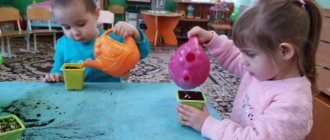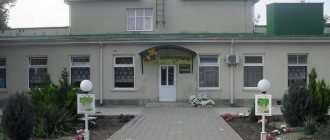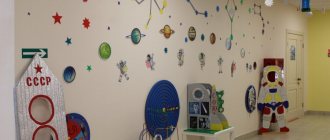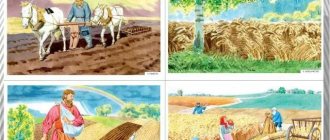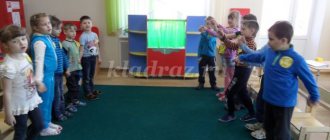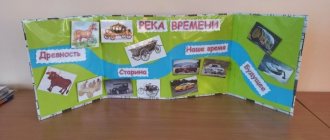Practical lesson “Vegetable garden on the windowsill”
Tasks. Activate children's understanding of the appearance of seeds: tomato, cucumber, dill, planting skills. Clarify children's understanding that a plant grows from seeds. To develop the ability to plant seeds correctly by making a hole. Develop speech, enrich vocabulary, ability to listen carefully, and answer questions posed.
Materials and equipment. Watering cans with water, containers with soil, seeds (tomato, cucumber, beets), plates, Fedora doll.
Progress of the lesson.
Educator. Guys, look how many different things I prepared for you, oh, what is this box, it wasn’t here. (Tears off the box, lies the bell, rings it.)
Fedora appears.
Educator. Guys, who came to us? This is Fedor's grandmother. Why are you so sad, what happened.
Fedora. Every spring I plant a lot of different vegetables, but this time I’m afraid I won’t succeed. My cat Murka was playing and mixed all the seeds for me. But my eyes don’t see well, and now I can’t tell where the seeds are. Help me please, guys.
Educator. Let's help Fedora. The guys and I were just looking at different seeds, and today we wanted to plant a vegetable garden on the windowsill, give us your seeds here. Guys, first we will sort out the seeds and then plant them. Name what seeds are here. (Children call the seeds of beans, peas, onions.)
Educator. Guys, I suggest you put the seeds on plates. You have plates of different colors. Matvey, Vika, Artem, what color plate do you want to collect the seeds in? (green) Amina, Lyuda, Vova, and you? (blue). (Children complete the task.)
Educator. Well done, guys, you laid out the seeds correctly. And today I want to introduce you to other seeds, but first guess the riddles.
I'm important and juicy
My cheeks are red. (Tomato.)
There is grass above the ground,
Burgundy head underground. (Beet.)
No windows, no doors
The room is full of people. (Cucumber.)
Educator. Look at these tomato seeds. What are they? (rough, round, shaggy). And these are cucumber seeds. What are they? (oval, yellow, hard). And here are the beet seeds. What are they? (brown, round, prickly).
Look how interesting it is that a beautiful and juicy fruit grows from such a small seed (the teacher shows a diagram of plant growth).
And now you and I will plant our seeds. What needs to be done for this? (First you need to make a hole and put one seed there, then sprinkle it with earth and water it from a watering can.)
Educator. But we will plant beets by making a furrow and sowing seeds. (The teacher shows how to do this.) How many of you know what needs to be done to make the seeds germinate faster? (Cover with film, place in a warm place, there should be light.)
The children plant a vegetable garden with the help of the teacher and Fedora.
Fedora. Well, guys, what a great fellow you are. They helped me sort the seeds, and I learned how to germinate the seeds even faster. And now it's time for me to go home. (He says goodbye and leaves.)
Q. Well, guys, did you like our lesson? We will watch how our plants grow.
MAGAZINE Preschooler.RF
Abstract of GED “GARDEN ON THE WINDOW”Goal: to develop children’s interest in experimental and research activities in growing cultivated plants indoors
Tasks:
- give children primary ideas about certain living conditions of plants and organisms (soil, moisture, temperature, sun, light);
- to develop children’s ecological culture and interest in search activities;
- introduce children to different types of seeds, root crops, and methods of caring for plant crops;
- enrich your vocabulary;
- develop cognitive interest and activity: planting and caring for plants; observing the stages of their growth; keeping observation diaries; harvesting.
- teach dialogue, instill conversation skills.
Relevance:
From birth, a child is a discoverer, an explorer of the world that surrounds him. And especially a preschool child. The more deeply a child learns about the mysteries of the world around him, the more questions he has. The main task of an adult is to help the child find answers to these questions on his own. To satisfy children's curiosity, to instill the first skills of activity and independent thinking. The world of plants is amazing and diverse. Every attentive observer and thoughtful researcher can discover something new in it.
A Chinese proverb says: “Tell me and I will forget, show me and I will remember, let me try and I will understand . This is how a child learns everything firmly and for a long time when he hears, sees and does it himself. Therefore, design and research activities have taken their place in the system of work in kindergarten, because every child is a little researcher who discovers the world around him with joy and surprise. The child strives for active activity; it is important not to let this desire fade away and to promote his further development. The more complete and varied a child’s activities, the more successful the child’s development is, and the first creative manifestations are realized. The “Vegetable Garden on the Window” laboratory allows you to monitor the growth and development of plants, conduct experimental work to identify factors influencing the growth and development of plants and obtain sustainable labor skills and skills in caring for vegetable garden crops.
Project stages
- Preparatory stage
- Practical stage
- The final stage
- Preparatory stage
- Defining the goals and objectives of the project,
- Collection of information material necessary for the implementation of the project..
- Conversations with children (identifying the level of knowledge about plants)
- Drawing up a work plan for the project.
- Development of lesson notes and presentations on the planned topic.
- Organization of a subject-development environment on the topic of the project.
- Make signs with the children with the names of plants for our beds.
- Collection of fiction poems, riddles, proverbs, sayings, stories, tales about vegetables.
- Interaction with family. Collecting seeds needed for planting. Joint discussion of activities to implement the project.
- Practical stage
For 1st junior group
- Show at the Repka
- Conversation on the topic “What is water for?”
- Viewing the educational presentation “Mishkin’s vegetable garden”
- Educational album "Seeds"
- Didactic game “What's wrong with the store? What's from the garden?
- Working with the laptop “Fruits and vegetables”
- Planting onions
- Familiarization with the surrounding world “Whether in the garden or in the vegetable garden”
- Reading fiction.
Guessing riddles about vegetables and fruits.
10. Game activity. Pi "Cucumber"
11. Drawing “Bow from seven ailments”
12. Teacher’s story: “Where vitamins live”
For junior group 2:
- Conversations: “Necessary conditions for plant growth”
- Observing the growth of the onion root system in water. "Earth and Sprout"
- Reading fiction: A. Barto “Carrot Juice”
- Game activity. Dee: “Wonderful bag” , “Guess by taste”
- Working with the laptop “Fruits and vegetables”
- View the educational album “All about seeds”
- Labor activity: Sowing radish and zucchini seeds. Watering and caring for plants under the guidance of a teacher.
- Consultation for parents: “About onions for children”
- Dramatization-game “Once upon a time a housewife came from the market .
- Application "Bow"
- Didactic game “What grows where?”
- Experimenting "Waking the Bean"
For the middle group
- Application “Big and small tomatoes”
- Game situation: “Let’s prepare borscht for the dolls”
- Reading I. Tokmakov “Buy a bow”
- Working with the laptop “Vegetables and fruits”
- View a developmental presentation
- Dramatization of the fairy tale “Turnip”
- Game-re-enactment with masks “Fruits and vegetables”
- Creation of a collection of vegetable seeds.
- View the developmental presentation “Properties of Water”
- Experimentation “Without light there is trouble, with light there is beauty”
- Consultation for parents: “The use of onions in folk medicine”
- Labor activity: Sowing carrot and pea seeds. Watering and caring for plants
For the older group
- Role-playing game “Vegetable shop”
- Theatrical activity “The Tale of How the Vegetables Quarreled”
- View the educational album “Types of soils”
- Outdoor games “Collect all the items” , “Collecting the harvest” , “Garden and vegetable garden”
- Watching the cartoon "Chippolino"
- Thematic conversations: “Why do plants need seeds?” , “Vegetables” , “Water and soil are vegetables’ best friends”
- Drawing on the topic: “Vegetable soup”
- Conversation “Can vegetables harm your health”
- compiling the story “Summer at the Dacha”
- Reading: poems - S. Vitaly “Vegetable Garden” , S. Sirena “Vegetable Garden” , O. Emelyanova “What Grows in the Vegetable Garden”
- Examining flower seeds through a magnifying glass.
- "Planting Vegetable Seeds"
For the preparatory group
- Experience - observing the growth of onions and oats.
- Drawing “Our plants”
- Watching the educational presentation “Mishka’s in the Garden”
- View the educational album “Types of soils”
- Memorizing the poem “Oh, that feisty bow”
- Role-playing game “At the Dacha”
- Printed board game “Tops and Roots” “Fourth Odd”
- Outdoor games “Our garden is in order” , “Unload the car” , “Gather the harvest” , “Harvest” , “Sorting vegetables” .
- Finger games “We chop cabbage” , “There are many beds in the garden”
- round dance "Garden round dance"
- Compiling stories from personal experience “What grows in our dacha?”
- Making a diary of plant growth observations
- The final stage
Making an observation diary,
Making a card index of riddles,
photo album “Vegetable garden on the window”
presentation of the project “Vegetable garden on the window”
| Next > |
GREENS FOR CHILDREN
But, in most cases, kids don’t like greens in their pure form. Most likely, this is due to its rich taste. Or the child gives preference to one type, categorically rejecting others. In such a situation, there is no need to insist. You can add a very small amount of chopped greens to first or second courses, or to salads. Over time, the child will get used to this supplement. After all, not all vegetables, fruits and berries are to your liking the first time. Sometimes it takes time to try a particular product.
When can you give greens to your child? Greens can appear in children's diets from the eighth month. But to do this, it should be thoroughly crushed using a blender. And then add small amounts to various dishes. After a year, it will be enough to finely chop the green leaves or onion feathers with a knife. And after one and a half years, the baby can be offered various vegetable salads with the addition of herbs. A tasty salad made from various types of greens, to which hard-boiled and finely chopped eggs is added. This dish should be seasoned with vegetable oil and lightly salted.
Any greenery grows on the ground, so in order to avoid the appearance of such an unpleasant problem as Worms in a child, special attention should be paid to washing it. It is not enough to simply rinse a green bunch under running water. First, place it in a container of water and let it stand for a few minutes. This way the soil particles will become wet and will be easier to wash off. Then rinse the leaves several times in a new portion of water. After this, rinse them in running water and place them on a clean, dry towel. After the water has drained, you can start cooking.
